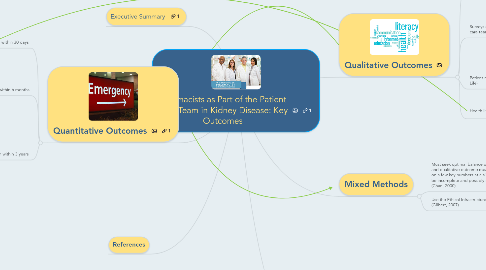
1. References
2. Quantitative Outcomes
2.1. Short-term within 30 days
2.1.1. medication list concordance
2.1.2. Identification of medication-related problems
2.1.3. Comprehension of medication information
2.2. Intermediate within 6 months
2.2.1. Dialysis Example: Proportion of patients achieving serum phosphorus concentration ≤5.5 mg/dL . (Mayne, 2012) MANAGEMENT BY FACTS (Gilbert, 2007)
2.2.2. Dialysis treatment adherence
2.3. Long-term within 3 years
2.3.1. Mortality rate
2.3.2. Hospitalization rate
2.3.3. Hospital length of stay
2.3.4. Rate of hospital readmission within 30 days of discharge
2.3.5. Total health care system costs. ACCOUNTABILITY (Gilbert, 2007)
3. Qualitative Outcomes
3.1. Patient satisfaction with medication therapy management by pharmacists. ENGAGEMENT (Gilbert, 2007)
3.1.1. Caregiver satisfaction with medication therapy management by a pharmacists
3.2. Surveys of other members of the health care team
3.2.1. Nurses
3.2.2. dialysis technicians
3.2.3. Physicians
3.2.4. PAs
3.2.5. Social workers
3.2.6. Dieticians
3.3. Patient-reported Outcomes (e.g. Quality of Life)
3.4. Health literacy (Wright-Nunes, 2011)
3.4.1. REALM
3.4.2. TOHFLA
3.4.3. Newest Vital Sign
